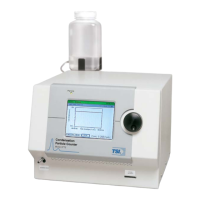Technical Description 5-3
Other significant developments in adiabatic-expansion CNCs
include the use of electrical photodetectors to measure the light
attenuation from cloud formation (Bradbury and Meuron [1938],
Nolan and Pollak [1946], Rich [1955], Pollak and Metneiks [1959]);
the use of under- and overpressure systems; and automation using
electrically controlled valves and flow systems. The amount of light
attenuated from the droplet cloud is monotonically related to the
concentration of particles and is calibrated either by manual
counting techniques, calculated from theory of particle light-
scattering, or by using an electrical classification and counting
method (Liu and Pui [1974]). A historical review of the expansion
CNCs is given by Nolan [1972], Hogan [1979], and Miller and
Bodhaine [1982].
Two-Flow Mixing CNC
Another cooling method turbulently mixes two vapor-saturated
flows, one hot and one cold, to rapidly cool and supersaturate the
vapor (Kousaka et al. [1982]). The condensation and droplet growth
are fairly rapid and uniform. The flows can be passed continuously
(that is, non-pulsating) through the mixing chamber onto a single-
particle-counting optical detector.
Diffusional Thermal CNC
A continuous-flow, diffusional, alcohol-based, thermal-cooling CNC
(Bricard et al. [1976], Sinclair and Hoopes [1975], Agarwal and Sem
[1980]) first saturates the air sample with alcohol vapor as the
sample passes over a heated pool of liquid alcohol. The vapor-
saturated air stream flows into a cold condenser tube where the air
is cooled by thermal diffusion. The alcohol condenses onto the
particles and the droplets grow to about 10 to 12 micrometers. The
droplets are counted by a single-particle-counting optical detector.
Continuous-flow, diffusional, water-based CPCs (TSI Model 3781,
3782, 3785, and 3786 WCPCs) were developed between 2003 and
2006. Using a patented technique (Technology from Aerosol
Dynamic Inc., U.S. Patent No. 6,712,881), an aerosol sample is
drawn continuously through a cooled saturator and then into a
heated condenser, where water vapor diffuses to the centerline of
the condenser faster than heat is transferred from the warm walls,
producing supersaturated conditions for water vapor condensing
onto the particles.
The Model 3760, 3762, and 3010 were introduced in early 90s and
was replaced by Model 3772/3771 in 2005. Both the 3772/3771
CPCs and the 3782 WCPC work only in the single count mode at
relatively high aerosol flow rates of 1.0 and 0.6 L/min, respectively.

